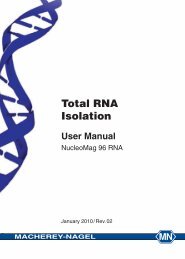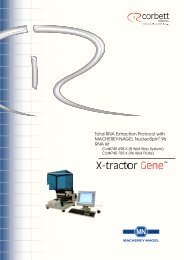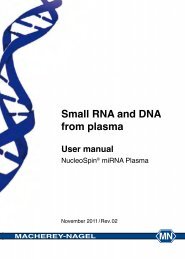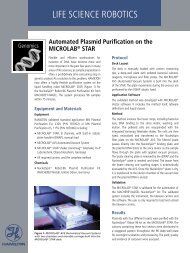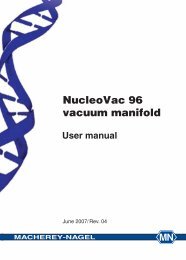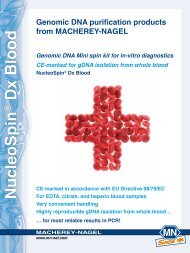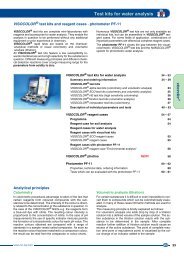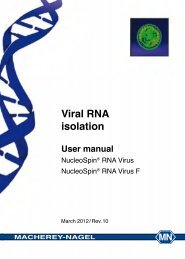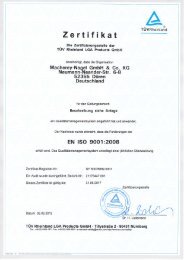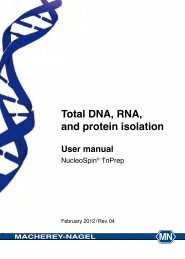NucleoBond® Xtra Maxi - Support Protocol for ... - Macherey Nagel
NucleoBond® Xtra Maxi - Support Protocol for ... - Macherey Nagel
NucleoBond® Xtra Maxi - Support Protocol for ... - Macherey Nagel
You also want an ePaper? Increase the reach of your titles
YUMPU automatically turns print PDFs into web optimized ePapers that Google loves.
NucleoBond ®<br />
<strong>Xtra</strong> <strong>Maxi</strong><br />
<strong>Support</strong> <strong>Protocol</strong><br />
<strong>for</strong> Large Constructs<br />
December 2008/Rev. 01<br />
MACHEREY-NAGEL<br />
MN
NucleoBond ® <strong>Xtra</strong> <strong>Maxi</strong> - <strong>Support</strong> <strong>Protocol</strong> <strong>for</strong> Large Constructs<br />
Table of contents<br />
1 NucleoBond ® <strong>Xtra</strong> <strong>Maxi</strong> - <strong>Support</strong> protocol <strong>for</strong> purification of BACs and other<br />
large constructs 4<br />
1.1 Field of application 4<br />
1.2 Growth of bacterial cultures 4<br />
1.3 Culture volume <strong>for</strong> large constructs 6<br />
1.4 Cell lysis 7<br />
1.5 Difficult-to-lyse strains 8<br />
1.6 Washing of the column 8<br />
1.7 Elution of large construct DNA 8<br />
1.8 Concentration of large construct DNA 8<br />
2 NucleoBond ® <strong>Xtra</strong> <strong>Maxi</strong> - Purification of BAC DNA 10<br />
3 Appendix 15<br />
3.1 Troubleshooting 15<br />
3.2 Ordering in<strong>for</strong>mation 22<br />
3.3 Product use restriction / warranty 22<br />
MACHEREY-NAGEL – 12/2008/ Rev. 01 3
NucleoBond ® <strong>Xtra</strong> <strong>Maxi</strong> - <strong>Support</strong> <strong>Protocol</strong> <strong>for</strong> Large Constructs<br />
1 NucleoBond ® <strong>Xtra</strong> <strong>Maxi</strong> - <strong>Support</strong> protocol <strong>for</strong><br />
purification of BACs and other large constructs<br />
1.1 Field of application<br />
This support protocol can be used in combination with NucleoBond ® <strong>Xtra</strong> <strong>Maxi</strong> Kits<br />
which are intended <strong>for</strong> the purification of plasmid DNA. Due to the size and low-copy<br />
nature of large constructs like BACs, PACs, P1 constructs, or cosmids the<br />
purification procedure has to be modified <strong>for</strong> optimal results.<br />
This support protocol cannot replace a specialized kit <strong>for</strong> purification of large<br />
constructs like NucleoBond ® <strong>Xtra</strong> BAC (currently under development). However, it<br />
might help if large constructs are to be purified occasionally.<br />
Note: The buffer volumes included in the NucleoBond ® <strong>Xtra</strong> kit will not be sufficient if<br />
a larger number of BAC preps is per<strong>for</strong>med. Additional buffer volumes can be<br />
ordered, see ordering in<strong>for</strong>mation.<br />
1.2 Growth of bacterial cultures<br />
Yield and quality of large construct DNA highly depend on the type of culture media<br />
and antibiotics, the bacterial host strain, the type of DNA, size, and copy number but<br />
also on the growth conditions.<br />
For large constructs like BAC, PAC, P1, or cosmid DNA LB (Luria-Bertani) medium is<br />
strongly recommended. The cell culture should be grown to an OD 600 of 1.5-2.0 to<br />
prevent starvation of the cells and degradation of large constructs. There<strong>for</strong>e,<br />
incubate at 32-37°C preferably 12-16 h over night. Use flasks of at least three or four<br />
times the volume of the culture volume and shake at 200-250 rpm to provide a<br />
growth medium fully saturated with oxygen.<br />
Alternatively to LB, rich media like 2xYT (Yeast/Tryptone), TB (Terrific Broth) or<br />
CircleGrow can be used. In this case bacteria grow faster, reach the stationary phase<br />
much earlier than in LB medium (≤ 12 h), and reach higher cell masses. However,<br />
this does not necessarily yield more DNA. Overgrowing a culture might lead to a<br />
higher percentage of dead or starving cells and the resulting BAC, PAC, P1, or<br />
cosmid DNA might be partially degraded or contaminated with chromosomal DNA.<br />
To find the optimal culture conditions, the culture medium and incubation times have<br />
to be optimized <strong>for</strong> each host strain/large construct combination individually.<br />
Cell cultures should be grown under antibiotic selection at all times to ensure large<br />
construct DNA propagation. Without this selective pressure, cells tend to lose a large<br />
construct during cell division. Since bacteria grow much faster without the burden of<br />
an additional chromosome, they take over the culture rapidly and the yield goes<br />
down regardless of the cell mass. Table 1 gives in<strong>for</strong>mation on concentrations of<br />
commonly used antibiotics.<br />
4<br />
MACHEREY-NAGEL – 12/2008/ Rev. 01
NucleoBond ® <strong>Xtra</strong> <strong>Maxi</strong> - <strong>Support</strong> <strong>Protocol</strong> <strong>for</strong> Large Constructs<br />
Table 1: In<strong>for</strong>mation about antibiotics according to Maniatis ∗<br />
Antibiotic<br />
Stock solution<br />
(concentration)<br />
Storage<br />
Working<br />
concentration<br />
Ampicillin 50 mg/ml in H 2 O -20°C 50-100 µg/ml<br />
Chloramphenicol 34 mg/ml in EtOH -20°C 25-170 µg/ml<br />
Kanamycin 10 mg/ml in H 2 O -20°C 10-50 µg/ml<br />
Streptomycin 10 mg/ml in H 2 O -20°C 10-50 µg/ml<br />
Tetracycline 5 mg/ml in EtOH -20°C 10-50 µg/ml<br />
The E. coli host strain mostly influences the quality of the large construct DNA.<br />
Whereas strains like DH5α or XL1-Blue usually produce high quality super-coiled<br />
DNA, other strains like e.g. HB101 with high levels of endonuclease activity might<br />
yield lower quality large construct giving poor results in downstream applications like<br />
enzymatic restriction or sequencing. Upon problems with host strains like Top10,<br />
HB101, or its derivatives like TG1, JM100 a change to DH5α or XL1-Blue should be<br />
considered.<br />
The type of large construct, especially the size and the origin of replication (ori)<br />
has a crucial influence on DNA yield. In general, the larger the construct or the<br />
cloned insert is, the lower is the expected DNA yield due to a lower copy number.<br />
Cosmids or BACs e.g. are maintained at copy numbers
NucleoBond ® <strong>Xtra</strong> <strong>Maxi</strong> - <strong>Support</strong> <strong>Protocol</strong> <strong>for</strong> Large Constructs<br />
1.3 Culture volume <strong>for</strong> large constructs<br />
Due to the influence of growth media (TB, CircleGrow, 2xYT), growth conditions<br />
(shaking, temperature, incubation time), host strain or type of insert etc. the final<br />
amount of cells in a bacterial culture can vary over a wide range. By rule of thumb,<br />
1 liter of E. coli culture with an OD 600 of 1 consists of 1 x 10 12 cells and yields about<br />
1.5-1.8 g cell wet weight. Overnight cultures containing a large construct and grown<br />
in LB medium usually reach an OD 600 of 3 under vigorous shaking in flasks. The<br />
expected DNA yield <strong>for</strong> a large construct is approximately 30-40 µg per gram cell wet<br />
weight.<br />
It is there<strong>for</strong>e important to adjust the cell mass rather than the culture volume <strong>for</strong><br />
the best large construct purification results. But since the cell mass or cell wet weight<br />
is tedious to determine it was replaced in this manual by the mathematical product of<br />
optical density at 600 nm (OD 600 ) and culture volume (Vol) - two variables that are<br />
much easier to measure.<br />
ODV = OD 600 x Vol [ml]<br />
Note that <strong>for</strong> a correct OD determination the culture samples have to be diluted if<br />
OD 600 exceeds 0.5 in order to increase proportionally with cell mass. For a well<br />
grown E. coli culture a 1:10 dilution with fresh culture medium is recommended. The<br />
measured OD 600 is then multiplied with the dilution factor 10 to result in a theoretical<br />
OD 600 value. This OD 600 is used in Table 2 to determine the appropriate culture<br />
volume. Table 2 shows recommended ODVs and the corresponding pairs of OD 600<br />
and culture volume that can be easily handled using the standard kit protocol lysis<br />
buffer volumes. For example, if the OD 600 of your E. coli culture is 2, use 900 ml<br />
culture <strong>for</strong> your BAC preparation.<br />
Table 2: Recommended culture volumes <strong>for</strong> large constructs<br />
NucleoBond ®<br />
<strong>Xtra</strong><br />
Pellet<br />
wet<br />
weight<br />
Rec.<br />
ODV<br />
=<br />
OD 600<br />
x Vol<br />
Recommended culture volume <strong>for</strong><br />
OD 600 = OD 600 = OD 600 = OD 600 = OD 600 =<br />
2 3 4 5 6<br />
<strong>Maxi</strong> 3.4 g 1800 900 ml 600 ml 450 ml 360 ml 300 ml<br />
6<br />
MACHEREY-NAGEL – 12/2008/ Rev. 01
NucleoBond ® <strong>Xtra</strong> <strong>Maxi</strong> - <strong>Support</strong> <strong>Protocol</strong> <strong>for</strong> Large Constructs<br />
1.4 Cell lysis<br />
The bacterial cell pellet is resuspended in Buffer RES and lysed by a sodium<br />
hydroxide/SDS treatment with Buffer LYS. Proteins, as well as chromosomal and<br />
large construct DNA are denatured under these conditions. RNA is degraded by<br />
DNase-free RNase A. Large construct lysates have to be treated even more<br />
carefully than plasmid DNA lysates to avoid nicking and irreversible<br />
denaturation of the large constructs - there<strong>for</strong>e shaking or vortexing of the<br />
lysate must be avoided. Neutralization Buffer NEU, containing potassium acetate,<br />
is then added to the lysate, causing SDS to precipitate as KDS (potassium dodecyl<br />
sulfate) and pulling down proteins, chromosomal DNA, and other cellular debris. The<br />
potassium acetate buffer also neutralizes the lysate. Circular DNA can revert to its<br />
native super-coiled structure and remains in solution.<br />
The NucleoBond ® <strong>Xtra</strong> buffer volumes according to the standard protocol are<br />
adjusted to ensure optimal lysis <strong>for</strong> culture volumes given in section 1.3, Table 2.<br />
Using too much cell material leads to inefficient cell lysis and precipitation and might<br />
reduce large construct yield and purity. There<strong>for</strong>e, lysis buffer volumes should be<br />
increased when applying larger culture volumes.<br />
By rule of thumb, calculate the necessary lysis buffer volumes <strong>for</strong> RES, LYS,<br />
and NEU as follows:<br />
Vol. [ml] = Culture Volume [ml] x OD 600 / 20<br />
Note that this <strong>for</strong>mula differs from the one <strong>for</strong> plasmid DNA to ensure<br />
maximum yield <strong>for</strong> large constructs.<br />
For example, if 900 ml of a bacterial culture (OD 600 = 2, ODV = 1800) is to be lysed,<br />
the appropriate volumes of lysis buffers RES, LYS, and NEU are 90 ml each. If more<br />
lysis buffer is needed than is provided with the kit, an additional buffer set including<br />
buffers RES, LYS, NEU, and RNase A can be ordered separately (see ordering<br />
in<strong>for</strong>mation).<br />
If less than the recommended amount of cells is to be used e.g. due to bad cell<br />
growth or limited culture volumes, less lysis buffer volumes can be used than given in<br />
the standard protocol (90 ml each). Calculate the necessary amount according to the<br />
above given <strong>for</strong>mula. Note that the yield might then be significantly lower than<br />
100 µg.<br />
By using sufficient amounts of lysis buffer, lysis time can be limited to 3-4 minutes<br />
and should not exceed 5 minutes. Prolonged exposure to alkaline conditions can<br />
irreversibly denature and degrade especially large construct DNA and liberate<br />
contaminating chromosomal DNA into the lysate.<br />
MACHEREY-NAGEL – 12/2008/ Rev. 01 7
NucleoBond ® <strong>Xtra</strong> <strong>Maxi</strong> - <strong>Support</strong> <strong>Protocol</strong> <strong>for</strong> Large Constructs<br />
1.5 Difficult-to-lyse strains<br />
For large construct purification of e.g. Gram-positive bacteria or strains with a more<br />
resistant cell wall it might be advantageous to start the preparation with a lysozyme<br />
treatment. There<strong>for</strong>e, resuspend the cell pellet in Buffer RES containing 2 mg/ml<br />
lysozyme and incubate at 37°C <strong>for</strong> 30 minutes. Proceed then with the lysis<br />
procedure according to the NucleoBond ® <strong>Xtra</strong> standard protocol.<br />
1.6 Washing of the column<br />
The high salt concentration of the lysate prevents proteins and RNA from binding to<br />
the NucleoBond ® <strong>Xtra</strong> Column. However, to remove all traces of contaminants and<br />
to purge the dead volume of the NucleoBond ® <strong>Xtra</strong> Column Filters it is important to<br />
wash the column and the filter in two subsequent washing steps.<br />
First apply Buffer EQU to the funnel rim of the filter to wash all residual lysate out of<br />
the filter onto the column. Do not just pour the buffer inside the filter. Then pull out<br />
and discard the column filter or remove the filter by turning the column upside down.<br />
It is essential to wash the NucleoBond ® <strong>Xtra</strong> Column without filter <strong>for</strong> a second time<br />
with Wash Buffer WASH. This ensures highest yields with best achievable purity.<br />
However, due to the expected small amounts of large construct DNA compared to<br />
the large binding capacity there is a lot of free space <strong>for</strong> RNA to be held back. If RNA<br />
contamination of large construct preparations is observed increase the WASH buffer<br />
volumes (double, triple). For additional Buffer WASH see ordering in<strong>for</strong>mation.<br />
1.7 Elution of large construct DNA<br />
Elution is carried out under high-salt conditions and by a shift of pH from 7.0 to 9.0.<br />
Under these alkaline conditions the positive charge of the anion-exchange resin is<br />
neutralized and large construct DNA is released. To facilitate the dissociation of large<br />
construct DNA from the resin ELU should be heated to 65-70°C. The elution<br />
efficiency can be increased further by preventing the elution buffer from cooling down<br />
to fast. There<strong>for</strong>e either incubate the column at 50-60°C during elution or apply the<br />
elution buffer in smaller 1-2 ml portions (heated to 65-70°C).<br />
1.8 Concentration of large construct DNA<br />
For any downstream application it is necessary to precipitate the DNA and to remove<br />
salt and all traces of alcohol since they disturb or inhibit enzymatic activity needed <strong>for</strong><br />
restriction or sequencing reactions.<br />
All NucleoBond ® <strong>Xtra</strong> eluates already contain enough salt <strong>for</strong> an isopropanol<br />
precipitation of DNA. Thus, the precipitation is started by directly adding 0.7 volumes<br />
of isopropanol. To prevent co-precipitation of salt, use room-temperature (20-25°C)<br />
isopropanol only and do not let the large construct DNA solution drop into a vial with<br />
isopropanol but add isopropanol to the final eluate and mix immediately.<br />
8<br />
MACHEREY-NAGEL – 12/2008/ Rev. 01
NucleoBond ® <strong>Xtra</strong> <strong>Maxi</strong> - <strong>Support</strong> <strong>Protocol</strong> <strong>for</strong> Large Constructs<br />
DNA is then collected by centrifugation and washed with 70% ethanol according to<br />
the standard protocol. Attention should be paid at the drying step. All liquid should be<br />
allowed to evaporate completely at room temperature to reduce contamination of<br />
large construct DNA with ethanol. On the other hand any over-drying will render the<br />
DNA harder to dissolve and should be avoided.<br />
To dissolve large constructs completely incubate in an appropriate volume of buffer<br />
at 4°C over night. Use only pipet tips with a large opening or cut the tip to increase<br />
the opening to prevent large constructs from shearing.<br />
Concentration of BAC, PAC, or P1 constructs with NucleoBond ® Finalizer or<br />
Finalizer Large is not recommended. The recovery drops with increasing size of the<br />
construct due to tighter binding of large DNA to the NucleoBond ® Finalizer<br />
membrane (Use of NucleoBond ® Finalizer is only recommended <strong>for</strong> vector sizes<br />
smaller than 50 kbp)!<br />
MACHEREY-NAGEL – 12/2008/ Rev. 01 9
NucleoBond ® <strong>Xtra</strong> <strong>Maxi</strong> - <strong>Support</strong> <strong>Protocol</strong> <strong>for</strong> Large Constructs<br />
2 NucleoBond ® <strong>Xtra</strong> <strong>Maxi</strong> - Purification of BAC<br />
DNA<br />
1 Prepare a starter culture<br />
Inoculate a 3-5 ml starter culture of LB medium with a single colony picked from a<br />
freshly streaked agar plate. Make sure that plate and liquid culture contain the<br />
appropriate selective antibiotic to guarantee large construct propagation (see 1.2<br />
<strong>for</strong> more in<strong>for</strong>mation). Shake at 32-37°C and ~300 rpm <strong>for</strong> ~8 h.<br />
2 Prepare large overnight cultures<br />
Inoculate three 300 ml overnight cultures in 1000 ml Erlenmeyer flasks by diluting<br />
the starter culture 1/1000 into the given volumes of LB medium also containing<br />
the appropriate selective antibiotic. Refer to section 1.3 <strong>for</strong> larger culture volumes<br />
if the cultures are known to grow poorly.<br />
Grow the cultures overnight at 32-37°C and 200-250 rpm <strong>for</strong> 12-16 h.<br />
Note: To utilize the entire large binding capacity of the NucleoBond ® <strong>Xtra</strong> <strong>Maxi</strong> Columns it<br />
is important to provide enough large construct DNA. If you are not sure about the large<br />
construct copy number and growth behavior of your host strain, increase the culture<br />
volume and decide in step 3 how much cells to use <strong>for</strong> the preparation. The culture<br />
volume recommended below is calculated <strong>for</strong> a final OD 600 of around 2 and should yield<br />
around 100 µg of large construct DNA (see to section 1.3 <strong>for</strong> more in<strong>for</strong>mation).<br />
3 x 300 ml<br />
3<br />
Harvest bacterial cells<br />
Measure the cell culture OD 600 and determine the recommended culture volume<br />
V [ml] = 1800 / OD 600<br />
Pellet the cells by centrifugation at 4,500 - 6,000 x g <strong>for</strong> ≥10 min at 4°C and<br />
discard the supernatant completely.<br />
Note: It is of course possible to use more than the recommended amount of cells. In this<br />
case increase RES, LYS and NEU buffer volumes proportionally in steps 4, 5, and 7 (see<br />
section 1.4 <strong>for</strong> more in<strong>for</strong>mation). Additional lysis buffer might have to be ordered<br />
separately (see ordering in<strong>for</strong>mation <strong>for</strong> NucleoBond ® <strong>Xtra</strong> Buffer Set I, section 3.2). It<br />
might be necessary to use a centrifuge <strong>for</strong> the lysate clarification in step 8 rather than the<br />
NucleoBond ® <strong>Xtra</strong> Column Filters.<br />
10<br />
MACHEREY-NAGEL – 12/2008/ Rev. 01
NucleoBond ® <strong>Xtra</strong> <strong>Maxi</strong> - <strong>Support</strong> <strong>Protocol</strong> <strong>for</strong> Large Constructs<br />
4 Resuspension (Buffer RES)<br />
Resuspend the cell pellet completely in Resuspension Buffer RES + RNase A<br />
by pipetting up and down or vortexing the cells.<br />
For an efficient cell lysis it is important that no clumps remain in the suspension.<br />
Note: Increase RES buffer volume proportionally if more than the recommended cell<br />
mass is used (see section 1.4 <strong>for</strong> in<strong>for</strong>mation on optimal cell lysis and section 1.5<br />
regarding difficult-to-lyse strains).<br />
90 ml<br />
5 Cell lysis (Buffer LYS)<br />
Check Lysis Buffer LYS <strong>for</strong> precipitated SDS prior to use. If a white<br />
precipitate is visible, warm the buffer <strong>for</strong> several minutes at 30-40°C until<br />
precipitate is dissolved completely. Cool buffer down to room temperature (20-<br />
25°C).<br />
Add Lysis Buffer LYS to the suspension.<br />
Mix gently by inverting the tube 5 times. Do not vortex as this will shear and<br />
release contaminating chromosomal DNA from cellular debris into the suspension.<br />
Incubate the mixture at room temperature (20-25°C) <strong>for</strong> 5 min.<br />
Note: Increase LYS buffer volume proportionally if more than the recommended cell mass<br />
is used (see section 1.4 <strong>for</strong> in<strong>for</strong>mation on optimal cell lysis).<br />
90 ml<br />
6 Equilibration (Buffer EQU)<br />
Equilibrate a NucleoBond ® <strong>Xtra</strong> <strong>Maxi</strong> Column together<br />
with the inserted column filter with Equilibration Buffer<br />
EQU.<br />
Apply the buffer onto the rim of the column filter as shown<br />
in the picture and make sure to wet the entire filter.<br />
Allow the column to empty by gravity flow. The column<br />
does not run dry.<br />
30 ml<br />
MACHEREY-NAGEL – 12/2008/ Rev. 01 11
NucleoBond ® <strong>Xtra</strong> <strong>Maxi</strong> - <strong>Support</strong> <strong>Protocol</strong> <strong>for</strong> Large Constructs<br />
7 Neutralization (Buffer NEU)<br />
Add Neutralization Buffer NEU to the suspension and immediately mix the lysate<br />
gently by inverting the tube 10-15 times. Do not vortex.<br />
The flask or tube used <strong>for</strong> this step should not be filled more than two thirds to<br />
allow homogeneous mixing. Make sure to neutralize completely to precipitate all<br />
the protein and chromosomal DNA. The lysate should turn from a slimy, viscous<br />
consistency to a low viscosity, homogeneous suspension of an off-white<br />
flocculate.<br />
Incubate lysate on ice <strong>for</strong> 5 min.<br />
Note: Increase NEU buffer volume proportionally if more than the recommended cell<br />
mass is used (see section 1.4 <strong>for</strong> in<strong>for</strong>mation on optimal cell lysis).<br />
90 ml<br />
8 Clarification and loading<br />
Make sure to have a homogeneous suspension of the precipitate by inverting the<br />
tube 3 times directly be<strong>for</strong>e applying the lysate to the equilibrated NucleoBond ®<br />
<strong>Xtra</strong> Column Filter to avoid clogging of the filter.<br />
The lysate is simultaneously cleared and loaded onto the column. Refill the filter if<br />
more lysate has to be loaded than the filter is able to hold. Allow the column to<br />
empty by gravity flow.<br />
Alternative: The precipitate can be removed by centrifugation at ≥ 5,000 x g <strong>for</strong> at<br />
least 10 min, e.g. if more than the recommended cell mass was used. If the<br />
supernatant still contains suspended matter transfer it to a new tube and repeat<br />
the centrifugation, preferably at higher speed, or apply the lysate to the<br />
equilibrated NucleoBond ® <strong>Xtra</strong> Column Filter.<br />
This clarification step is extremely important since residual precipitate may clog<br />
the NucleoBond ® <strong>Xtra</strong> <strong>Maxi</strong> Column. To load the column you can either apply the<br />
cleared lysate to the equilibrated filter or remove the unused filter be<strong>for</strong>ehand.<br />
Allow the column to empty by gravity flow.<br />
Note: You may want to save all or part of the flow-through <strong>for</strong> analysis (see section 3.1).<br />
Optional: Final yield might be increased by reloading the lysate flow-through a second<br />
time especially if the amount of DNA is close to the binding capacity of the NucleoBond ®<br />
<strong>Xtra</strong> <strong>Maxi</strong> Column.<br />
12<br />
MACHEREY-NAGEL – 12/2008/ Rev. 01
NucleoBond ® <strong>Xtra</strong> <strong>Maxi</strong> - <strong>Support</strong> <strong>Protocol</strong> <strong>for</strong> Large Constructs<br />
9 Wash column filter and column (Buffer EQU)<br />
Wash the NucleoBond ® <strong>Xtra</strong> Column Filter and<br />
NucleoBond ® <strong>Xtra</strong> <strong>Maxi</strong> Column with Equilibration Buffer<br />
EQU.<br />
Apply the buffer to the funnel shaped rim of the filter and<br />
make sure it is washing out the lysate which is remaining<br />
in the filter. Omitting this step or just pouring the buffer<br />
directly inside the funnel may reduce DNA yield.<br />
15 ml<br />
10 Discard column filter<br />
Either pull out the NucleoBond ® <strong>Xtra</strong> Column Filter or discard it by<br />
turning the column upside down.<br />
11 Wash column (Buffer WASH)<br />
Wash the NucleoBond ® <strong>Xtra</strong> <strong>Maxi</strong> Column with Wash Buffer WASH.<br />
It is important to remove the column filter be<strong>for</strong>e applying Buffer<br />
WASH to avoid a low purity.<br />
45 ml<br />
12<br />
Elution (Buffer ELU)<br />
Heat Elution Buffer ELU to 65-70°C.<br />
Remove the waste container and place a 15 ml or 50 ml centrifuge tube (not<br />
provided) under the column. Elute the large construct DNA with hot Elution<br />
Buffer ELU.<br />
Note: The elution efficiency can be increased by preventing the elution buffer from cooling<br />
down to fast. There<strong>for</strong>e either incubate the column at 50-60°C during elution or apply the<br />
elution buffer in smaller 2-3 ml portions (heated to 65-70°C).<br />
The overall yield can be increased even further by a second elution step with additional<br />
10 ml of hot elution buffer.<br />
Determine large construct yield by UV spectrophotometry be<strong>for</strong>e precipitating the DNA in<br />
order to adjust desired concentration of DNA in step 15 and calculate the recovery after<br />
precipitation.<br />
15 ml<br />
MACHEREY-NAGEL – 12/2008/ Rev. 01 13
NucleoBond ® <strong>Xtra</strong> <strong>Maxi</strong> - <strong>Support</strong> <strong>Protocol</strong> <strong>for</strong> Large Constructs<br />
13 Precipitation<br />
Add 0.7 volumes of room-temperature isopropanol to precipitate the eluted<br />
large construct DNA. Vortex well and let the mixture sit <strong>for</strong> 2 minutes.<br />
Centrifuge at ≥ 5,000 x g <strong>for</strong> ≥15 min at ≤ room temperature, preferably at<br />
15,000 x g <strong>for</strong> 30 min at 4°C. Carefully discard the supernatant.<br />
10.5 ml<br />
14 Wash and dry DNA pellet<br />
Add room-temperature 70% ethanol to the pellet and centrifuge at ≥ 5,000 x g,<br />
preferably ≥ 15,000 x g <strong>for</strong> 5 min at room temperature (20-25°C).<br />
5 ml<br />
Carefully remove ethanol completely from the tube with a pipette tip. Allow the<br />
pellet to dry completely at room temperature (20-25°C).<br />
Note: DNA might be harder to dissolve when over-dried.<br />
5-10 min<br />
15 Reconstitute DNA<br />
Add an appropriate volume of buffer TE or sterile H 2 O to dissolve the pellet.<br />
Less than 500 µl can be applied if the yield is expected to be very low.<br />
500-1000 µl<br />
Ideally incubate over night at 4°C to dissolve BAC DNA completely.<br />
Avoid frequent pipetting up and down since large DNA constructs are prone to<br />
shearing. Rather shake the tube gently and use only pipette tips with a large<br />
opening or cut the tip to increase the opening.<br />
4°C over night<br />
If the dissolved DNA pellet is very viscous, add more buffer TE or H 2 O to ensure<br />
complete dissolving and a correct quantification.<br />
Determine large construct yield by UV spectrophotometry.<br />
14<br />
MACHEREY-NAGEL – 12/2008/ Rev. 01
NucleoBond ® <strong>Xtra</strong> <strong>Maxi</strong> - <strong>Support</strong> <strong>Protocol</strong> <strong>for</strong> Large Constructs<br />
3 Appendix<br />
3.1 Troubleshooting<br />
If you experience problems with reduced yield or purity, it is recommended to check<br />
which purification step of the procedure is causing the problem.<br />
First, the bacterial culture has to be checked <strong>for</strong> sufficient growth (OD 600 ) in the<br />
presence of an appropriate selective antibiotic (Table 1, section 1.2). Second,<br />
aliquots of the cleared lysate, the flow-through, the combined washing steps (Buffer<br />
EQU and Buffer WASH), and the eluate should be kept <strong>for</strong> further analysis by<br />
agarose gel electrophoresis.<br />
Choose at least 1000 µl of the cleared lysate, flow-through, and combined washing<br />
steps as well as 200 µl of the eluate.<br />
Precipitate the nucleic acids by adding 0.7 volumes of isopropanol. Centrifuge the<br />
samples, wash the pellets using 70% ethanol, centrifuge again, remove supernatant,<br />
air dry <strong>for</strong> 10 minutes, dissolve the DNA in 30 µl TE buffer, pH 8.0, and run 20-30 µl<br />
on a 1% agarose gel.<br />
The exemplary gel picture (Figure 1) will help you to address the specific questions<br />
outlined in the following section more quickly and efficiently.<br />
It shows e.g. the dominant large construct bands which should only be present in the<br />
eluate and in the lysate be<strong>for</strong>e loading to proof large construct production in your cell<br />
culture (lane 1). Large construct DNA found in the wash fractions, however, narrows<br />
down the problem to wrong or bad wash buffers (e.g. wrong pH, buffer components<br />
precipitated, evaporation of liquid due to wrong storage).<br />
RNA might be visible as a broad band at the bottom of the gel <strong>for</strong> the lysate and the<br />
lysate flow-through samples (lanes 1 and 2). It might also occur in the wash fraction<br />
but must be absent in the eluate.<br />
Genomic DNA should not be visible at all but would show up in the gel slot or right<br />
below indicating e.g. too harsh lysis conditions.<br />
MACHEREY-NAGEL – 12/2008/ Rev. 01 15
NucleoBond ® <strong>Xtra</strong> <strong>Maxi</strong> - <strong>Support</strong> <strong>Protocol</strong> <strong>for</strong> Large Constructs<br />
Figure 1<br />
Exemplary analytical check of NucleoBond ® <strong>Xtra</strong> <strong>Maxi</strong> purification of BAC samples<br />
Large construct: 240 kbp BAC, bacterial strain: E. coli DH5α. 20 µl of each precipitated<br />
sample has been analyzed on a 1% agarose gel. Equal amounts of large construct DNA<br />
be<strong>for</strong>e (lane 1) and after (lane 4) purification using NucleoBond ® <strong>Xtra</strong> <strong>Maxi</strong> are shown with<br />
a recovery of > 90%.<br />
M 1 2 3 4 5<br />
M: Marker λ HindIII<br />
1: Cleared lysate, large construct and degraded RNA<br />
2: Lysate flow-through, no large construct DNA, but degraded RNA<br />
3: Wash flow-through, no large construct DNA or residual RNA<br />
4: Eluate, pure large construct DNA<br />
5: EcoRI restriction<br />
16<br />
MACHEREY-NAGEL – 12/2008/ Rev. 01
NucleoBond ® <strong>Xtra</strong> <strong>Maxi</strong> - <strong>Support</strong> <strong>Protocol</strong> <strong>for</strong> Large Constructs<br />
Problem<br />
Possible cause and suggestions<br />
Large construct did not propagate<br />
• Check large construct content in the cleared lysate (see Figure<br />
6). Use colonies from fresh plates <strong>for</strong> inoculation and add<br />
selective antibiotic to plates and media.<br />
Alkaline lysis was inefficient<br />
• Too much cell mass was used. Refer to section 1.3-1.4<br />
regarding recommended culture volumes and lysis buffer<br />
volumes. Check large construct content in the cleared lysate<br />
(see Figure 1).<br />
• Check Buffer LYS <strong>for</strong> SDS precipitation be<strong>for</strong>e use, especially<br />
after storage below 20°C. If necessary incubate the bottle <strong>for</strong><br />
several minutes at 30-40°C and mix well until SDS is redissolved.<br />
No or low<br />
large<br />
construct DNA<br />
yield<br />
SDS- or other precipitates are present in the sample<br />
• Load the crude lysate onto the NucleoBond ® <strong>Xtra</strong> Column Filter<br />
inserted in the NucleoBond ® <strong>Xtra</strong> <strong>Maxi</strong> Column. This ensures<br />
complete removal of SDS precipitates. Incubation of cleared<br />
lysates <strong>for</strong> longer periods of time might lead to <strong>for</strong>mation of new<br />
precipitate. If precipitate is visible, it is recommended to filter or<br />
centrifuge the lysate again directly be<strong>for</strong>e loading it onto the<br />
NucleoBond ® <strong>Xtra</strong> <strong>Maxi</strong> Column.<br />
Sample/lysate is too viscous<br />
• Too much cell mass was used. Refer to section 1.3-1.4<br />
regarding recommended culture volumes and lysis buffer<br />
volumes.<br />
• Make sure to mix well after neutralization to completely<br />
precipitate SDS and chromosomal DNA. Otherwise, filtration<br />
efficiency and flow rate go down and SDS prevents DNA from<br />
binding to the column.<br />
pH or salt concentrations of buffers are too high<br />
• Check large construct content in the wash fractions (see Figure<br />
1). Keep all buffers tightly closed. Check and adjust pH of Buffer<br />
EQU (pH 6.5) and ELU (pH 9.0) with HCl or NaOH if necessary.<br />
MACHEREY-NAGEL – 12/2008/ Rev. 01 17
NucleoBond ® <strong>Xtra</strong> <strong>Maxi</strong> - <strong>Support</strong> <strong>Protocol</strong> <strong>for</strong> Large Constructs<br />
Problem<br />
NucleoBond ®<br />
<strong>Xtra</strong> Column<br />
Filter clogs<br />
during<br />
filtration<br />
NucleoBond ®<br />
<strong>Xtra</strong> <strong>Maxi</strong><br />
Column is<br />
blocked or<br />
very slow<br />
Possible cause and suggestions<br />
Culture volumes are too large<br />
• Refer to section 1.3-1.4 regarding recommended culture<br />
volumes and larger lysis buffer volumes.<br />
Precipitate was not resuspended be<strong>for</strong>e loading<br />
• Invert crude lysate at least 3 times directly be<strong>for</strong>e loading.<br />
Incomplete precipitation step<br />
• Make sure to mix well after neutralization to completely<br />
precipitate SDS and chromosomal DNA.<br />
Sample is too viscous<br />
• Do NOT attempt to purify lysate prepared from a culture volume<br />
larger than recommended with standard lysis buffer volumes.<br />
Incomplete lysis does not only block the column but can also<br />
significantly reduce yields. Refer to section 1.3 <strong>for</strong><br />
recommended culture volumes and section 1.4 <strong>for</strong> larger culture<br />
volumes and adjusted lysis buffer volumes.<br />
• Make sure to mix well after neutralization to completely<br />
precipitate SDS and chromosomal DNA.<br />
Lysate was not cleared completely<br />
• Use NucleoBond ® <strong>Xtra</strong> Column Filter or centrifuge at higher<br />
speed or <strong>for</strong> a longer period of time.<br />
• Precipitates occur during storage. Clear lysate again be<strong>for</strong>e<br />
loading the column.<br />
RNase digestion was inefficient<br />
• RNase was not added to Buffer RES or stored improperly. Add<br />
new RNase to Buffer RES (see section 3.2 <strong>for</strong> ordering<br />
in<strong>for</strong>mation).<br />
RNA<br />
contamination<br />
of large<br />
construct DNA<br />
pH or salt concentration of wash buffer is too low<br />
• Check RNA content in the wash fractions (see Figure 1). Keep<br />
all buffers tightly closed. Check pH of Buffer EQU (pH 6.5) and<br />
WASH (pH 7.0) and adjust with HCl or NaOH if necessary.<br />
• For BAC purifications the stringency of Buffer WASH can be<br />
increased by adjusting the pH to 7.5 in order to remove RNA<br />
more efficiently.<br />
18<br />
MACHEREY-NAGEL – 12/2008/ Rev. 01
NucleoBond ® <strong>Xtra</strong> <strong>Maxi</strong> - <strong>Support</strong> <strong>Protocol</strong> <strong>for</strong> Large Constructs<br />
Problem<br />
Possible cause and suggestions<br />
DNA visible in the pocket of an agarose gel was mistaken <strong>for</strong><br />
genomic DNA<br />
• Genomic DNA contamination is usually too low to be seen on an<br />
agarose gel. DNA in the gel loading pockets usually is denatured<br />
large construct DNA. Don’t grow the culture to stationary phase.<br />
Allow <strong>for</strong> longer re-hybridization after neutralization (i.e. increase<br />
incubation after addition of Buffer NEU) and use more TE buffer<br />
or H 2 O to dissolve large construct completely.<br />
Genomic DNA<br />
contamination<br />
of large<br />
construct DNA<br />
Lysis treatment was too harsh<br />
• Make sure not to lyse in Buffer LYS <strong>for</strong> more than 5 min.<br />
Lysate was mixed too vigorously or vortexed after lysis<br />
• Invert tube <strong>for</strong> only 5 times. Do not vortex after addition of LYS.<br />
• Use larger tubes or reduce culture volumes <strong>for</strong> easier mixing.<br />
Remaining small amounts of genomic DNA interfere with<br />
downstream application<br />
• Digest linear DNA with Exonuclease (not provided). Note that<br />
not only genomic DNA will be digested but also linear or nicked<br />
large construct DNA. The overall yield will be significantly lower.<br />
NucleoBond ® <strong>Xtra</strong> Column Filter was not removed be<strong>for</strong>e second<br />
washing step<br />
• Protein content too high due to inefficient washing. Remove the<br />
NucleoBond ® <strong>Xtra</strong> Column Filter be<strong>for</strong>e per<strong>for</strong>ming the second<br />
washing step with Buffer WASH.<br />
Low purity<br />
(A 260 /A 280<br />
< 1.8)<br />
Buffer WASH was used instead of Buffer EQU <strong>for</strong> the first wash<br />
• Buffer EQU has to be used to wash out the NucleoBond ® <strong>Xtra</strong><br />
Column Filter to avoid SDS carryover.<br />
Only minimal amounts of DNA were loaded onto the column<br />
• Excess free binding capacity requires more extensive washing –<br />
double washing step with Buffer WASH.<br />
• Reduce lysis time < 5 min.<br />
MACHEREY-NAGEL – 12/2008/ Rev. 01 19
NucleoBond ® <strong>Xtra</strong> <strong>Maxi</strong> - <strong>Support</strong> <strong>Protocol</strong> <strong>for</strong> Large Constructs<br />
Problem<br />
Possible cause and suggestions<br />
Pellet was lost<br />
• Handle the precipitate with care. Decant solutions carefully.<br />
Determine DNA yield in Buffer ELU in order to calculate the<br />
amount of large construct DNA that should be recovered after<br />
precipitation.<br />
No nucleic<br />
acid pellet<br />
<strong>for</strong>med after<br />
precipitation<br />
Large construct DNA might be smeared over the wall of the tube<br />
• Dissolve DNA with an appropriate volume of reconstitution buffer<br />
by rolling the tube <strong>for</strong> at least 30 min, better several hours.<br />
Nucleic acid did not precipitate<br />
• Check type and volumes of precipitating solvent. Make sure to<br />
use at least 0.7 volumes of isopropanol and mix thoroughly.<br />
• Centrifuge <strong>for</strong> longer periods of time at higher speed.<br />
Nucleic acid<br />
pellet is<br />
opaque or<br />
white instead<br />
of clear and<br />
glassy<br />
Nucleic acid<br />
pellet does<br />
not resuspend<br />
in buffer<br />
Co-precipitation of salt<br />
• Check isopropanol purity, and per<strong>for</strong>m precipitation at room<br />
temperature (20-25°C) but centrifuge at 4°C. Do not let the<br />
eluate drip from the column into isopropanol but add isopropanol<br />
to the final eluate and mix immediately.<br />
• Try to dissolve the pellet in Buffer WASH, and reload onto the<br />
same NucleoBond ® <strong>Xtra</strong> <strong>Maxi</strong> Column. Wash the column<br />
several times with Buffer WASH be<strong>for</strong>e loading.<br />
Pellet was over-dried<br />
• Try to dissolve at higher temperatures <strong>for</strong> a longer period of time<br />
(e.g. 2 h at 37°C or overnight at RT), preferably under constant<br />
spinning (3D-shaker).<br />
Co-precipitation of salt or residual alcohol<br />
• Wash the pellet again with 70% ethanol, or increase the<br />
reconstitution buffer volume.<br />
20<br />
MACHEREY-NAGEL – 12/2008/ Rev. 01
NucleoBond ® <strong>Xtra</strong> <strong>Maxi</strong> - <strong>Support</strong> <strong>Protocol</strong> <strong>for</strong> Large Constructs<br />
Problem<br />
Purified large<br />
construct does<br />
not per<strong>for</strong>m<br />
well in<br />
subsequent<br />
reactions<br />
Possible cause and suggestions<br />
Large construct is contaminated with chromosomal DNA or RNA<br />
• Refer to the detailed troubleshooting above.<br />
Large construct is contaminated with residual alcohol<br />
• Large construct pellet was not dried completely be<strong>for</strong>e<br />
dissolving. Precipitate DNA again by adding 1/10 volume of 3 M<br />
NaAc pH 5.0 and 0.7 volumes of isopropanol. Proceed with the<br />
precipitation protocol in this manual und dry DNA pellet<br />
completely.<br />
DNA is degraded<br />
• Use only pipette tips with a large opening <strong>for</strong> dissolving large<br />
constructs to avoid shearing of the DNA, e.g. cut off 1 cm of the<br />
pipette tip to increase the opening.<br />
Purified large<br />
construct does<br />
not per<strong>for</strong>m<br />
well in<br />
subsequent<br />
reactions<br />
(continued)<br />
• Make sure that your entire equipment (pipettes, centrifuge tubes<br />
etc.) is clean and nuclease-free.<br />
• Do not lyse the sample with Buffer LYS <strong>for</strong> more than 5 min.<br />
DNA is not completely re-hybridized<br />
• Increase incubation after neutralization (addition of Buffer NEU).<br />
DNA is not completely dissolved<br />
• Use more TE buffer or H 2 O to dissolve large construct DNA<br />
pellet after precipitation.<br />
MACHEREY-NAGEL – 12/2008/ Rev. 01 21
NucleoBond ® <strong>Xtra</strong> <strong>Maxi</strong> - <strong>Support</strong> <strong>Protocol</strong> <strong>for</strong> Large Constructs<br />
3.2 Ordering in<strong>for</strong>mation<br />
Product Cat. No. Pack of<br />
NucleoBond ® <strong>Xtra</strong> <strong>Maxi</strong> 740414.10/.50/.100 10/50/100 preps<br />
NucleoBond ® <strong>Xtra</strong> Combi Rack 740415 1<br />
NucleoBond ® <strong>Xtra</strong> Buffer Set I<br />
(Buffer RES, LYS, NEU, RNase A)<br />
Buffer RES<br />
(without RNase A)<br />
740417 1<br />
740363.1000 1000 ml<br />
Buffer LYS 740329.1000 1000 ml<br />
Buffer NEU 740348.1000 1000 ml<br />
Buffer EQU 740317.1000 1000 ml<br />
Buffer WASH 740375.1000 1000 ml<br />
Buffer ELU 740316.600 600 ml<br />
RNase A 740505 100 mg<br />
RNase A 740505.50 50 mg<br />
3.3 Product use restriction / warranty<br />
NucleoBond ® <strong>Xtra</strong> <strong>Maxi</strong> kit components were developed, designed and sold <strong>for</strong><br />
research purposes only. They are suitable <strong>for</strong> in vitro uses only. No claim or<br />
representation is intended <strong>for</strong> its use to identify any specific organism or <strong>for</strong> clinical<br />
use (diagnostic, prognostic, therapeutic, or blood banking).<br />
It is rather the responsibility of the user to verify the use of the NucleoBond ® <strong>Xtra</strong><br />
<strong>Maxi</strong> kit <strong>for</strong> a specific application range as the per<strong>for</strong>mance characteristic of this kit<br />
has not been verified to a specific organism.<br />
This MACHEREY-NAGEL product is shipped with documentation stating<br />
specifications and other technical in<strong>for</strong>mation. MACHEREY-NAGEL warrants to meet<br />
the stated specifications. MACHEREY-NAGEL´s sole obligation and the customer´s<br />
sole remedy is limited to replacement of products free of charge in the event products<br />
fail to per<strong>for</strong>m as warranted. Supplementary reference is made to the general<br />
business terms and conditions of MACHEREY-NAGEL, which are printed on the<br />
price list. Please contact us if you wish an extra copy. MACHEREY-NAGEL does not<br />
warrant against damages or defects arising in shipping and handling (transport<br />
insurance <strong>for</strong> customers excluded), or out of accident or improper or abnormal use of<br />
this product; against defects in products or components not manufactured by<br />
22<br />
MACHEREY-NAGEL – 12/2008/ Rev. 01
NucleoBond ® <strong>Xtra</strong> <strong>Maxi</strong> - <strong>Support</strong> <strong>Protocol</strong> <strong>for</strong> Large Constructs<br />
MACHEREY-NAGEL, or against damages resulting from such non-MACHEREY-<br />
NAGEL components or products.<br />
MACHEREY-NAGEL makes no other warranty of any kind whatsoever, and<br />
SPECIFICALLY DISCLAIMS AND EXCLUDES ALL OTHER WARRANTIES OF ANY<br />
KIND OR NATURE WHATSOEVER, DIRECTLY OR INDIRECTLY, EXPRESS OR<br />
IMPLIED, INCLUDING, WITHOUT LIMITATION, AS TO THE SUITABILITY,<br />
REPRODUCTIVITY, DURABILITY, FITNESS FOR A PARTICULAR PURPOSE OR<br />
USE, MERCHANTABILITY, CONDITION, OR ANY OTHER MATTER WITH<br />
RESPECT TO MACHEREY-NAGEL PRODUCTS. In no event shall MACHEREY-<br />
NAGEL be liable <strong>for</strong> claims <strong>for</strong> any other damages, whether direct, indirect,<br />
incidental, compensatory, <strong>for</strong>eseeable, consequential, or special (including but not<br />
limited to loss of use, revenue or profit), whether based upon warranty, contract, tort<br />
(including negligence) or strict liability arising in connection with the sale or the failure<br />
of MACHEREY-NAGEL products to per<strong>for</strong>m in accordance with the stated<br />
specifications. This warranty is exclusive and MACHEREY-NAGEL makes no other<br />
warranty expressed or implied.<br />
The warranty provided herein and the data, specifications and descriptions of this<br />
MACHEREY-NAGEL product appearing in MACHEREY-NAGEL published<br />
catalogues and product literature are MACHEREY-NAGEL´s sole representations<br />
concerning the product and warranty. No other statements or representations, written<br />
or oral, by MACHEREY-NAGEL´s employees, agent or representatives, except<br />
written statements signed by a duly authorized officer of MACHEREY-NAGEL are<br />
authorized; they should not be relied upon by the customer and are not a part of the<br />
contract of sale or of this warranty. Product claims are subject to change. There<strong>for</strong>e<br />
please contact our Technical Service Team <strong>for</strong> the most up-to-date in<strong>for</strong>mation on<br />
MACHEREY-NAGEL products. You may also contact your local distributor <strong>for</strong><br />
general scientific in<strong>for</strong>mation. Applications mentioned in MACHEREY-NAGEL<br />
literature are provided <strong>for</strong> in<strong>for</strong>mational purposes only. MACHEREY-NAGEL does not<br />
warrant that all applications have been tested in MACHEREY-NAGEL laboratories<br />
using MACHEREY-NAGEL products. MACHEREY-NAGEL does not warrant the<br />
correctness of any of those applications.<br />
Please contact:<br />
MACHEREY-NAGEL Germany<br />
Tel.: +49 (0) 24 21 969 270<br />
e-mail: TECH-BIO@mn-net.com<br />
Last updated 12/2006, Rev. 02<br />
MACHEREY-NAGEL – 12/2008/ Rev. 01 23



